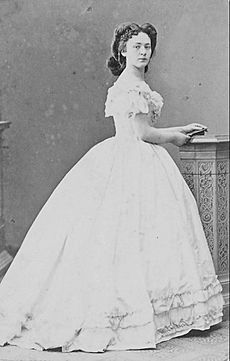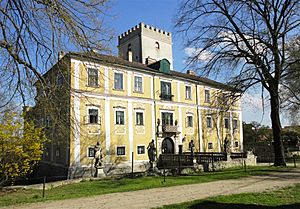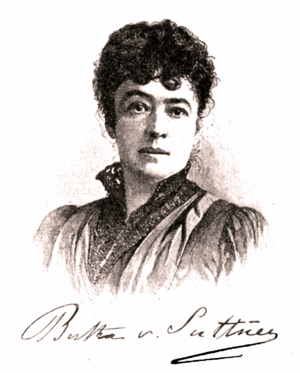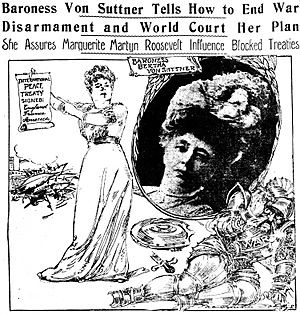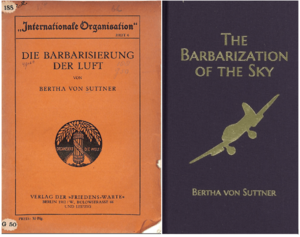Bertha von Suttner facts for kids
Quick facts for kids
Bertha von Suttner
|
|
|---|---|
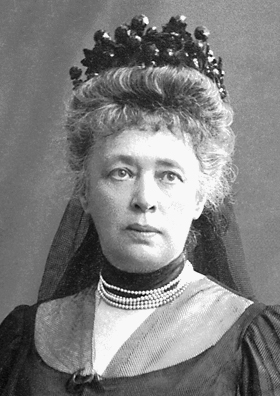
Suttner c. 1906
|
|
| Born | 9 June 1843 |
| Died | 21 June 1914 (aged 71) |
| Occupation | Pacifist, novelist |
| Spouse(s) | Arthur Gundaccar von Suttner |
| Awards | Nobel Peace Prize, 1905 |
| Signature | |
Bertha Sophie Felicitas Freifrau von Suttner (pronounced [ˈbɛʁtaː fɔn ˈzʊtnɐ]; born Countess Kinsky von Wchinitz und Tettau; June 9, 1843 – June 21, 1914) was an important Austrian writer and a strong supporter of peace. In 1905, she made history as the first woman to win the Nobel Peace Prize. She was also the first Austrian to receive any Nobel Prize.
Contents
Early Life and Education
Bertha Kinský was born on June 9, 1843, in Prague. Her father, Franz Michael, was a general who passed away before she was born. Her mother, Sophie Wilhelmine, was much younger than her father.
Bertha's family was part of the nobility, but her mother's side was of a lower rank. This meant Bertha faced some social challenges. Her family also didn't have a lot of money.
She grew up with her maternal aunt and cousin, Elvira. Elvira loved reading and learning, and she introduced Bertha to many books and ideas. Bertha learned French, Italian, and English from tutors. She also became a talented pianist and singer.
Bertha dreamed of becoming an opera singer. She took many lessons in Paris and Baden-Baden. However, she struggled with stage fright and couldn't perform well professionally.
Becoming a Tutor and Life in Georgia
In 1873, Bertha became a tutor for the four daughters of Karl, Freiherr von Suttner. She quickly fell in love with their older brother, Arthur Gundaccar von Suttner. He was seven years younger than her.
Arthur's parents did not approve of their relationship. In 1876, Bertha briefly worked as a secretary for Alfred Nobel in Paris. She and Nobel became friends, and he may have had romantic feelings for her. But Bertha was committed to Arthur.
She soon returned to Vienna and secretly married Arthur. The couple then moved far away to Mingrelia in Georgia. They hoped to use Bertha's connections to the local royal family.
In Georgia, they taught languages and music to children. Life was hard, and they lived in a simple wooden house. When the Russo-Turkish War started, Arthur became a reporter. Bertha also wrote for Austrian newspapers and began working on her first novels.
Writing and Peace Ideas
Living in Georgia, Bertha and Arthur began to write professionally to support themselves. Bertha's writing started to focus on political ideas. Her book, Inventarium einer Seele (Inventory of the Soul), published in 1883, showed her support for disarmament (reducing weapons). She believed that technology would eventually lead to world peace.
In 1885, Bertha and Arthur returned to Austria. They lived at Harmannsdorf Castle. Bertha found great happiness in her marriage to Arthur. She wrote in her diary about their jokes, walks, reading, and music. She felt that as long as they had each other, they had everything.
Leading the Peace Movement
After returning to Austria, Bertha focused on writing about peace and war. She was inspired by the International Arbitration and Peace Association.
In 1889, Bertha became a major figure in the peace movement. She published her famous novel, Die Waffen nieder! (Lay Down Your Arms!). This book made her one of the most important leaders of the Austrian peace movement. It was published in 37 editions and translated into 12 languages.
Bertha helped create the Austrian Gesellschaft der Friedensfreunde (Society of Friends of Peace) in 1891. The next year, she also founded the German Peace Society. She edited an international peace journal, also called Die Waffen nieder!, from 1892 to 1899.
In 1897, she asked Emperor Franz Joseph I of Austria to support an International Court of Justice. She also attended the First Hague Peace Conference in 1899.
After her husband Arthur died in 1902, Bertha moved back to Vienna. In 1904, she spoke at the International Congress of Women in Berlin. She also traveled across the United States for seven months, meeting President Theodore Roosevelt.
Bertha kept in touch with Alfred Nobel until his death in 1896. Many believe she influenced his decision to include a peace prize in his will. On December 10, 1905, Bertha von Suttner was awarded the Nobel Peace Prize. She received it for her work in promoting peace instead of war.
In 1907, Bertha was the only woman at the Second Hague Peace Conference. This meeting mainly discussed the laws of war. Bertha was critical of the conference. She warned that a war was coming. When she accepted her Nobel Peace Prize, she spoke about the importance of avoiding war. She hoped Europe would choose peace and law over destruction.
Bertha continued to campaign against countries building up their weapons before World War I. In 1911, she joined the advisory council of the Carnegie Endowment for International Peace. In the last months of her life, she helped organize another Peace Conference. Sadly, she died of cancer on June 21, 1914. Just seven days later, Franz Ferdinand was killed, which led to World War I.
Bertha's ideas about peace were shaped by thinkers like Immanuel Kant and Leo Tolstoy. She believed peace was a natural state. War and militarism were human mistakes. She argued that people had a right to peace under international law.
Writing Themes
Bertha von Suttner was a professional writer. She sometimes wrote novels she didn't fully believe in just to earn money. But even in those books, she included her political ideas. Often, her characters would fall in love because they shared the same ideals, like peace and tolerance.
She used her connections with wealthy people, like Alfred Nobel, to meet world leaders. This helped her promote her writing and her ideas. Early in her career, she used a male pen name to gain more success. She also worked as a journalist to spread her message and promote her books and causes.
Like Harriet Beecher Stowe, Bertha used entertainment to share important ideals. For Bertha, peace and acceptance of all people were the most important themes.
Bertha also wrote about other topics, especially religion and gender.
Religion in Her Work
Bertha often wrote about two main issues with religion. She disliked the showiness of some religious practices. In Lay Down Your Arms, she described a scene where the emperor and empress washed the feet of citizens. They did this to show humility, but they made it a big public event. The main character, Martha, called it "indeed a sham washing."
Another issue was the idea that war was fought for God. Leaders often used religion to justify war. Bertha criticized this. She argued that it made the state more important to God than individuals. It also made dying in battle seem more glorious than other forms of death. Much of Lay Down Your Arms explores this idea.
This kind of religious thinking also led to division and fighting based on religious differences. Bertha and Arthur von Suttner rejected this. Arthur, a devoted Christian, started the League Against Anti-Semitism. This was in response to attacks on Jewish communities in Europe. The Suttner family called for acceptance of all people and all faiths. Bertha wrote that "religion was neighbourly love, not neighbourly hatred."
Gender Roles
Bertha von Suttner is seen as a leader in the women's liberation movement.
She broke through gender barriers with her work as a writer and activist. In her time, women were often expected to be quiet. But Bertha was an outspoken leader. She didn't actively join movements for women's voting rights, saying she lacked time. Instead, she focused on connecting with other women in the international peace movement. She believed that both men and women must work together for peace. She wrote that "mankind's continuing ennoblement can only be fulfilled through fair and equal cooperation between the sexes."
In Lay Down Your Arms, the main character Martha often disagrees with her father about gender roles. Martha doesn't want her son to play with toy soldiers. She doesn't want him to be taught masculine ideas about war. Martha's father tries to push her back into traditional female roles. He suggests she should marry again because women her age shouldn't be alone.
Bertha showed how sexism affects both men and women. The character Tilling, for example, is also affected by male stereotypes. He says that men "have to repress the instinct of self-preservation." He also notes that soldiers must hide their compassion and sympathy. This is because "what is most disgraceful to us is all sentimentality, all that is emotional."
Legacy and Recognition
Even though Bertha von Suttner wasn't rich during her life, her work continues to inspire the peace movement.
- She won the Nobel Peace Prize in 1905.
She has also been honored on coins and stamps:
- She was featured on the 2008 Europe Taler coin. This coin celebrates important people in European history.
- Germany issued a silver 10 euro coin in 2005 to mark 100 years since her Nobel Prize.
- She appears on the Austrian 2 euro coin. She was also on the old Austrian 1,000 schilling bank note.
- She was honored on an Austrian postage stamp in 1965 and a German postage stamp in 2005.
- On December 10, 2019, Google celebrated her with a Google Doodle.
On Film and TV
- Die Waffen nieder, a film from 1914 by Holger Madsen and Carl Theodor Dreyer.
- No Greater Love (German: Herz der Welt), a 1952 film where Bertha is the main character.
TV Shows
- Madame Nobel (A Love for Peace – Bertha von Suttner and Alfred Nobel), a TV biopic from 2014.
Works Translated into English
- Memoirs of Bertha von Suttner: The Records of an Eventful Life. 1. Boston; London: Published for the International School of Peace by Ginn and Co.. 1910. OCLC 1000449. https://archive.org/details/memoirsberthavo03suttgoog/page/n9.
- Memoirs of Bertha von Suttner: The Records of an Eventful Life. 2. Boston; London: Published for the International School of Peace by Ginn and Co.. 1910. OCLC 1000449. https://archive.org/details/memoirsberthavo02suttgoog/page/n8.
- When Thoughts Will Soar: a romance of the immediate future. Boston; New York: Houghton Mifflin Company. 1914. OCLC 975993521. https://archive.org/details/whenthoughtswill00suttiala/page/n6.
- Lay Down Your Arms: The autobiography of Martha von Tilling (2nd ed.). New York: Longmans, Green & Co.. 1914. OCLC 944424434. https://archive.org/details/laydownyourarms01holmgoog/page/n7.
- The Barbarization of the Sky. Mount Pleasant, Michigan (USA): The Bertha von Suttner Project. 2016. OCLC 993005782. https://www.peacepalacelibrary.nl/2017/06/the-barbarization-of-the-sky/.
See Also
 In Spanish: Bertha von Suttner para niños
In Spanish: Bertha von Suttner para niños
- Pacifism
- List of peace activists
- List of Austrians
- List of Austrian writers
- List of female Nobel laureates


